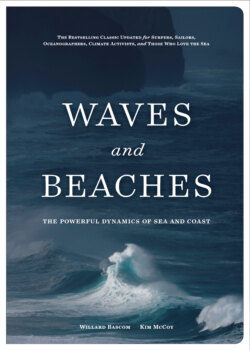Читать книгу Waves and Beaches - Kim McCoy - Страница 23
На сайте Литреса книга снята с продажи.
2Ideal Waves
ОглавлениеThe shape and motion of the ocean’s surface as waves pass across it is very complicated. It is little wonder that even after thousands of years of observation, seafarers developed no satisfactory explanation of the mechanics of wave motion. Ancient mariners knew in a general way that waves were generated by the winds, that they continued to travel outside the storm area, and that upon entering shallow water they would rise up and break, expending their energy on a beach or against a rocky headland. These characteristics were easily observable. Since ancient times the Polynesians have navigated vast distances aided by their knowledge of how waves interact with islands, are affected by currents, and propagate in the open ocean. They do not use any mathematics or computers, but they understand how waves can be refracted, reflected, and shoal, subjects that will be covered later in this book.
A major difficulty in explaining their origin and motion came from the fact that waves are so irregular. In the past, shipboard observers could see that when a breeze would suddenly spring up, a previously calm sea would first become rippled, and then in time and as the wind increased, these ripples would grow into larger and larger waves. Soon the ship would be surrounded by a full-fledged storm with large irregular masses of water moving on all sides, often breaking on the deck. There was no longer any chance to observe—the goal was to survive. Away from the wave-generating area the waves tended to be seen as somewhat more regular. These observations were confused by the simultaneous existence of several kinds of waves from different storms and by the curious effect of the underwater topography.
Observers on shore would see high waves intermixed with low ones; several would arrive in quick succession, and then the time between waves would be long—some would break, others not. In the midst of a period of calm weather and blue skies, suddenly great waves would arrive at a shore, and no one on the shore could explain why. No general set of rules for wave behavior could be worked out that seemed to cover all the conditions observed. Even careful observers could only say, “That is just the nature of waves.”
The obvious way to unpack such a complicated problem is to deal with each of the components, one at a time, in its simplest form. The first component of the problem is to define wave properties or dimensions and to determine the relationship between them. Next it would be necessary to discover what size and duration of storm and what velocity of wind created what kinds and sizes of waves. Finally, the relationship between wave motion and the depth of water needs to be worked out.
It seems easy now, with the advantage of hindsight and modern technology, to organize the wave-research program that could have been carried out many years ago, but, of course, nothing so systematic happened. Casual observations of many wave characteristics gradually led, step by step, to sufficient understanding that a beginning could be made on wave theory.
One can imagine that several of the important properties of waves were first thoughtfully noted many thousands of years ago by someone living on the shore of the sea. Probably this early scientist was regarded as the village slacker; probably making observations in a little cove with clear shallow water, a sandy bottom, and an occasional stalk of seaweed. The shore provided the vantage point to watch the waves of the sea move into the cove.
Not all waves are created equal. Irregular storm waves in the Antarctic engulf a vessel on all sides. The deck and chest-high rail are awash while 50-knot winds launch distant wave crests into the air. Drake Passage, Southern Ocean. Kim McCoy
One bright and sunny day when no breeze blew to ruffle the surface of the water, a series of regular waves entered the cove, moved across it, and broke on the beach at its head. Idly this scientist-by-accident tossed a stick into the water and watched it float there, noting its position in relation to a rock on the opposite shore. It would rise and fall and move back and forth as waves passed under, but it did not move shoreward with the waves. There was nothing new or startling here; others had also seen this countless times before. But suddenly the idea occurred in the person’s mind that waves are only moving forms and that the water stays in the same place. The stick, and the water around it, moved in a slow circular oscillation as each wave passed. The seaweed stalks were carefully observed growing upright from the bottom and moving in slow vertical circles. As a crest approached, the upper part of the weed moved toward it; as the crest passed, and the weed continued to point toward it until a new crest approached. Fragments of weed suspended in the water that were neither floating nor sinking moved in slow vertical circles, one for each passing wave. Here was a basic principle of hydrodynamics: Objects in the water tend to do what the water they displace would have done (see figure 7). The water particles also must be moving in circles.
FIGURE 7: The motions of seaweed indicate the movement of water particles as waves pass.
With these simple early observations oscillatory waves were discovered. This was an accomplishment roughly equivalent to Newton’s observation that an apple falls to the ground because of the force of gravity. Everyone had seen what it meant, but no one had thought about why. However, unlike Newton, early wave observers were not capable of expressing what they had seen in mathematical terms.
